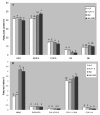Effect of the feeding system on the fatty acid composition, expression of the Delta9-desaturase, Peroxisome Proliferator-Activated Receptor Alpha, Gamma, and Sterol Regulatory Element Binding Protein 1 genes in the semitendinous muscle of light lambs of the Rasa Aragonesa breed
- PMID: 20649987
- PMCID: PMC2917425
- DOI: 10.1186/1746-6148-6-40
Effect of the feeding system on the fatty acid composition, expression of the Delta9-desaturase, Peroxisome Proliferator-Activated Receptor Alpha, Gamma, and Sterol Regulatory Element Binding Protein 1 genes in the semitendinous muscle of light lambs of the Rasa Aragonesa breed
Abstract
Background: Conjugated linoleic acids (CLAs) are receiving increasing attention because of their beneficial effects on human health, with milk and meat products derived from ruminants as important sources of CLA in the human diet. SCD gene is responsible for some of the variation in CLA concentration in adipose tissues, and PPARgamma, PPARalpha and SREBP1 genes are regulator of SCD gene. The aim of this work was to evaluate the effect of the feeding system on fatty acid composition, CLA content and relative gene expression of Delta9-desaturase (SCD), Peroxisome Proliferator-Activated Receptor Gamma (PPARgamma), Peroxisome Proliferator-Activated Receptor Alpha, (PPARalpha) and Sterol Regulatory Element Binding Protein (SREBP1) in Rasa Aragonesa light lambs in semitendinous muscle. Forty-four single-born male lambs were used to evaluate the effect of the feeding system, varying on an intensity gradient according to the use of concentrates: 1. grazing alfalfa, 2. grazing alfalfa with a supplement for lambs, 3. indoor lambs with grazing ewes and 4. drylot.
Results: Both grazing systems resulted in a higher concentration of vaccenic acid (VA), CLA, CLA/VA acid ratio, and a lower oleic content, oleic acid (C18:1)/stearic acid (C18:0) ratio, PUFA n-6/n-3 ratio and SCD expression compared to other diets. In addition feeding system affected the fatty acid composition and SCD expression, possibly due to CLA concentration or the PUFA n-6/n-3 ratio. Both expression of the SCD gene and the feeding system were important factors affecting CLA concentration in the animal's semitendinous muscle. PPARgamma, PPARalpha and SREBP1 expression seemed to be unaffected by the feeding system. Although no significant results were found, PPARgamma, PPARalpha and SREBP1 showed similar expression pattern as SCD. Moreover, the correlation results between SCD expression and PPARgamma (p < 0.01), as well as SREBP1 (p < 0.01) expression, may suggest that these genes were affecting SCD expression in a different way.
Conclusions: The data indicated that the feeding system is the main factor affecting the fatty acid composition and SCD gene expression, which is also affected by CLA and possibly by n-6/n-3 PUFAs.
Figures



Similar articles
-
Conjugated linoleic acids influence fatty acid metabolism in ovine ruminal epithelial cells.J Dairy Sci. 2016 Apr;99(4):3081-3095. doi: 10.3168/jds.2015-10042. Epub 2016 Feb 1. J Dairy Sci. 2016. PMID: 26830749
-
The effect of feeding system in the expression of genes related with fat metabolism in semitendinous muscle in sheep.Meat Sci. 2011 Sep;89(1):91-7. doi: 10.1016/j.meatsci.2011.04.003. Epub 2011 Apr 14. Meat Sci. 2011. PMID: 21543161
-
Differing effects of forage and concentrate diets on the oleic acid and conjugated linoleic acid content of sheep tissues: the role of stearoyl-CoA desaturase.J Anim Sci. 2004 Mar;82(3):747-58. doi: 10.2527/2004.823747x. J Anim Sci. 2004. PMID: 15032431
-
Peroxisome Proliferator-Activated Receptors (PPAR), fatty acids and microRNAs: Implications in women delivering low birth weight babies.Syst Biol Reprod Med. 2021 Feb;67(1):24-41. doi: 10.1080/19396368.2020.1858994. Syst Biol Reprod Med. 2021. PMID: 33719831 Review.
-
PPARgamma in human and mouse physiology.Biochim Biophys Acta. 2007 Aug;1771(8):999-1013. doi: 10.1016/j.bbalip.2007.03.006. Epub 2007 Mar 27. Biochim Biophys Acta. 2007. PMID: 17475546 Free PMC article. Review.
Cited by
-
Influence of Restricted Grazing Time Systems on Productive Performance and Fatty Acid Composition of Longissimus dorsi in Growing Lambs.Asian-Australas J Anim Sci. 2015 Aug;28(8):1105-15. doi: 10.5713/ajas.14.0937. Asian-Australas J Anim Sci. 2015. PMID: 26104518 Free PMC article.
-
Effects of Addition of Linseed and Marine Algae to the Diet on Adipose Tissue Development, Fatty Acid Profile, Lipogenic Gene Expression, and Meat Quality in Lambs.PLoS One. 2016 Jun 2;11(6):e0156765. doi: 10.1371/journal.pone.0156765. eCollection 2016. PLoS One. 2016. PMID: 27253325 Free PMC article.
-
Gene Expression and Fatty Acid Profiling in Longissimus thoracis Muscle, Subcutaneous Fat, and Liver of Light Lambs in Response to Concentrate or Alfalfa Grazing.Front Genet. 2019 Oct 31;10:1070. doi: 10.3389/fgene.2019.01070. eCollection 2019. Front Genet. 2019. PMID: 31737049 Free PMC article.
-
Effect of Breed on Transcriptional and Protein Expression of Lipogenic Enzymes in Tail and Subcutaneous Adipose Tissue from Two Grazing Breeds of Lambs.Animals (Basel). 2019 Feb 15;9(2):64. doi: 10.3390/ani9020064. Animals (Basel). 2019. PMID: 30781423 Free PMC article.
-
Isolation and characterization of ovine mesenchymal stem cells derived from peripheral blood.BMC Vet Res. 2012 Sep 22;8:169. doi: 10.1186/1746-6148-8-169. BMC Vet Res. 2012. PMID: 22999337 Free PMC article.
References
-
- West DB, Delany JP, Camet PM, Alicia FB, Truet A, Scimeca DJ. Effects of conjugated linoleic acid on body fat and energy metabolism in the mouse. Am J Physiol Regul Integr Comp Physiol. 1998;275:667–672. - PubMed
-
- Pariza MW, Park Y, Cook ME. Conjugated linoleic acid and the control of cancer and obesity. Toxicol Sci. 1999;52:107–110. - PubMed
-
- Kritchevsky D, Tepper SHA, Wright S, Tso P, Czarnecki SK. Influence of conjugated linoleic acid (CLA) on establishment and progression of atherosclerosis in rabbits. J Am Coll Nutr. 2000;19:472–477. - PubMed
Publication types
MeSH terms
Substances
LinkOut - more resources
Full Text Sources
Research Materials
Miscellaneous

